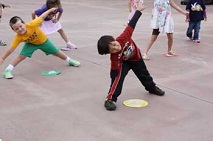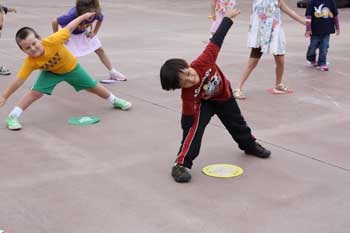The Benefits of Structured Physical Activity for Early Childhood Programs

Structured physical activities are usually led by a qualified adult and include organized sports, guided play, and school PE programs. Structured activities are important throughout a person’s life, but they play an essential role in early childhood—from birth to about five years of age. These are very tender years for a child. What they learn at this early age lays the groundwork for their future cognitive, social, emotional, and physical skills. Let’s take a look at how structured physical activity benefits early childhood programs. Together CountsTM partner, SPARK PE, breaks down the benefits of keeping your child active through structured physical activities.
1. Structured activities encourage healthy behaviors to dispel childhood obesity.
Aside from SPARK’s own research into the value physical activity plays in the lives of children under the age of 5, many other resources are coming up with similar findings. According to the Centers for Disease Control and Prevention, over a third of children and adolescents were overweight or obese in 2010. Obesity puts kids at an immediate risk for cardiovascular disease, prediabetes, and bone and joint problems, in addition to long term health concerns.
Structured activities go a long way to prevent excess weight and obesity. Studies show that obesity prevention programs in preschool are highly effective, particularly in areas of poverty. Participating in guided, controlled activities for just an hour a day burns calories, builds muscle, and encourages kids to maintain an active life as they grow older.
2. Structured physical activities develop motor skills, coordination, and movement at a young age.
Infants and toddlers are little balls of energy. They crawl, roll, kneel, creep up stairs, and eventually find themselves upright, taking their first tiny, stumbling steps. It’s no easy feat for an young child, but structured physical activity encourages movement and helps a child learn how his limbs and muscles can move in unison; in other words, the basics of coordination.
As their physical abilities develop, kids learn to use their hands more. Around the age of two, kids particularly enjoy finger play activities, like “The Itsy Bitsy Spider,” which assist in developing dexterity and hand-eye coordination. Other finger play exercises, like “Head, Shoulders, Knees, and Toes,” allow children to touch and identify different body parts.
As a Together Counts Partner, SPARK PE’s database of activities and lesson plans are open for you to explore. Examples of how Early Childhood lesson plans help improve these motor skills include: Hoop It Up, Super Stunts and Have a Ball. Feel free to review other sample lessons plans from the Early Childhood instructional unit.
3. Structured activity improves mood and self-esteem.
You know how great you feel after a run, thanks mainly to the production of endorphins, the good-feeling chemical that floods your body. The same happens to kids, but it’s not something they entirely need to understand. What they do understand is the fun and good times that come from engaging activities.
Structured activities provide kids with a positive body image—personal and otherwise—which builds self-confidence and gives them the emotional and social skills they need to cope with restrictive societal norms that define how a person “should look” in a healthy, positive manner.
SPARK is a research-based organization that provides award-winning, evidence-based programs for Physical Education (K-12), After School, Early Childhood, and Coordinated School Health and is a member of the Together Counts ProgramTM . Since 1989, SPARK has provided curriculum, training, and consultation to over 100,000 teachers and youth leaders worldwide. Visit www.sparkpe.org to download sample lesson plans, find grant opportunities, and register for free educational webinars and monthly eNewsletters.
For more physical activity tips, check out these resources:

